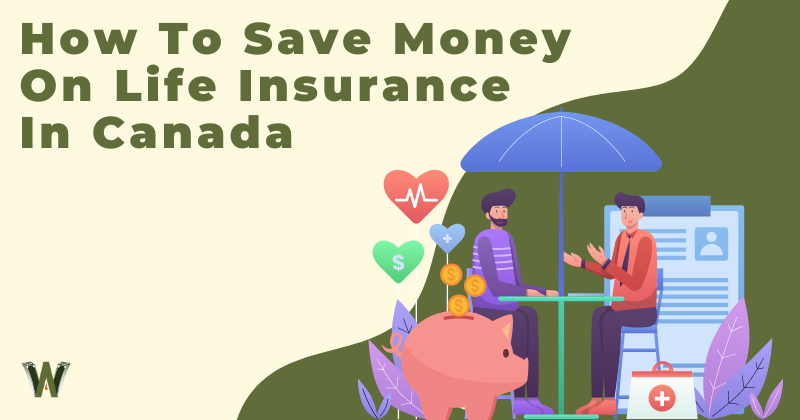Just 44% of Canadian households have a life insurance policy, according to a 2020 study by the Life Insurance Marketing and Research Association (LIMRA),
This indicates a decreasing trend compared to the 55% of households with a life insurance policy in 2006.
One of the reasons why fewer households are insured today could be the ever-increasing cost of premiums and policies.
With that in mind, here are seven steps on how to save money on life insurance in Canada:
- Take care of your body
- Apply for life insurance while you’re young
- Avoid dangerous activities
- Cut out the middleman (don’t shop with an agent)
- Compare policies online
- Stay away from “no-medical” policies
- Purchase term life insurance instead of permanent life insurance
Below, I’ll go over each of these steps and show you how to save on your policy, so you can get the most coverage for the lowest cost.
Insure Your Future With Life Insurance
Purchasing a life insurance policy isn’t about you; it’s about your family. If you were to pass away unexpectedly today, who would take care of your family? Would your spouse be able to afford the mortgage? Would your family be able to afford your funeral costs?
Purchasing a life insurance policy, even if it’s a simple term policy, can provide your family (and you) with peace of mind. No matter what happens, your family will be taken care of. They won’t have to give up their house or live in poverty.
Life insurance doesn’t have to be expensive, either.
Some insurance companies offer simple policies for less than $30 per month to young individuals in good health. That’s less than most people spend on coffee each month!
How To Save Money On Your Life Insurance Policy

Interested in purchasing your first life insurance policy? Before you call your local insurance agency and get stuck paying expensive middleman fees, check out these simple tips to save money on your premiums!
Step 1: Take Care Of Your Body
Insurance companies are similar to casinos – no matter how much the company pays out, the house always wins. Insurance companies limit their losses by charging high-risk individuals a higher rate.
Some examples of high-risk applicants could be those who:
- Smoke cigarettes (this is a BIG one)
- Drink excessively
- Are obese
- Have a history of drug abuse
This is purely based on numbers and data. Simply put, unhealthy individuals are statistically more likely to die prematurely, requiring the insurer to pay out the policy. For example, 72% of lung cancer cases are a direct result of tobacco use.
One of the easiest ways to save money on your life insurance policy is to stay healthy. If you’re a non-smoker, don’t drink often, have healthy body weight, exercise regularly, and don’t abuse drugs, then you’ll be a prime candidate for lower premiums.
Not in the best shape?
Give yourself a few months to quit smoking, start eating healthier, and start exercising. When you go for your initial physical exam, the doctor will give you a clean bill of health, and you’ll almost certainly pay less for your life insurance policy.
Plus, I guarantee you’ll feel a lot better!
Step 2: Apply While You’re Young
The younger you apply for your life insurance policy, the less you’ll pay. The older you are, the closer you are to a natural death, which means that you’ll pay more.
You have to be at least 18 to apply for a life insurance policy. However, if you apply in your 20s, you’ll get a far better deal compared to your 30s or 40s.
Applying in your 50s or 60s can be astronomically expensive.
Step 3: Avoid Dangerous Hobbies
During your life insurance policy application, you may be asked about any hobbies and activities you have that could be considered dangerous. Some examples of dangerous hobbies that could increase your life insurance cost include:
- Mountain climbing
- Scuba diving or free diving
- Piloting aircraft
- Skydiving
- Bungee jumping
- Car racing
- Off-roading
Granted, it’s difficult for insurers to determine whether you participate in these activities or not. However, you should be honest about these activities when you apply. Otherwise, the insurance company could use these activities as grounds to deny an insurance claim made by your family.
Step 4: Cut Out The Middleman
I get it – trying to purchase a life insurance policy can be confusing. With several different types of policies and a plethora of term options, payout amounts, benefits, and more to choose between, it can be helpful to get some professional advice.
Because of this, many consumers turn to life insurance agents to guide them through the process and help them choose the best option.
The only problem with this is that going through a life insurance agency is going to cost extra. Just like purchasing a car from a dealership, the middleman is going to take their commission fee for facilitating the deal.
If you want to cut costs and save on your life insurance policy, I encourage you to do your own research and purchase a policy without a major agency.
Step 5: Compare Policies Online
One of the best ways to cut out the middleman and compare rates you’re approved for is to compare policies online. I recommend PolicyAdvisor to readers who are looking for the best deals on life insurance.
The platform is free, simple, and easy to use.
All you need to do is input some basic personal information and you’ll be automatically paired with the best rates offered by competing life insurance companies. The advisors you’ll speak with aren’t paid on commission, which means that you won’t have to pay middleman fees.
Using PolicyAdvisor will often get you better deals compared to contacting insurance companies directly. Since multiple insurers are competing for your business, they’re more likely to offer premium rates when you use an insurance comparison tool.
Read my full review of PolicyAdvisor here.
Step 6: Avoid “No-Medical” Policies
As you’re shopping for life insurance, you’ll likely come across “no-medical” policies. These are life insurance policies that don’t require applicants to undergo a physical examination before approval.
No-medical policies have two key benefits:
- The approval process is quicker
- You can get approved for a policy even if you’re in poor physical health
However, no-medical policies are far more expensive than traditional term life insurance. Those who apply for these policies typically aren’t in the best shape, may have pre-existing medical conditions, or may be in a rush to secure a policy before a particularly dangerous event or job.
Either way you look at it, approving life insurance policies without a medical exam represents a considerable risk to the insurance company, which means that you’ll inevitably pay higher premiums.
Step 7: Purchase Term Life Insurance
There are three major types of life insurance:
- Term life insurance
- Permanent life insurance (or “whole life insurance”)
- Universal life insurance
Term and permanent life insurance are, by far, the most common. Universal life insurance is a newer type of policy that’s similar to a permanent life insurance policy but offers more flexibility.
Of the three types of life insurance, term life insurance policies are the least expensive.
Term life insurance is a simple policy that applicants purchase for a set term of time (between 5 and 20 years). Applicants agree to a specific payout and name a beneficiary to receive the payout in the event that they pass away during the policy term.
If you are still alive and complete the term, then the insurance company profits as it doesn’t have to issue any payments. Because of this, term policies are the most profitable for insurers, which is why they’re more affordable for consumers.
When Should I Apply For Life Insurance?

At this point, you may be wondering, “How young is too young to apply for life insurance? How do I know I’m ready to purchase life insurance?”
Like I mentioned, you’ll get the best rates on a life insurance policy if you apply while you’re still young and healthy. The older you get, the more expensive it will be to purchase a policy.
That being said, you also shouldn’t jump into buying life insurance if you don’t need it.
Most Canadians purchase their first life insurance policy until they start a family.
Once a spouse or children enter the picture, you’ll want to ensure that they’re cared for in the event that you no longer can.
That being said, you can name anybody as a beneficiary of your policy, including your parents or your best friend. If you’re providing for your parents or aging relatives, a term life policy can give you (and them) peace of mind knowing that they’ll be cared for if you’re no longer able to.
Can I Get Life Insurance With A Medical Condition?
Having a medical condition won’t automatically disqualify you from purchasing life insurance. However, most insurers will charge higher premiums to those with underlying medical conditions.
If your condition significantly increases your risk of premature death, then some insurers may deny your application outright, though. If you have pre-existing conditions, then you may want to consider applying for a no-medical life insurance policy.
How Much Life Insurance Do I Need?

This really varies, depending on your needs. Most term life policies pay out amounts between $100,000 and $1 million. The more valuable your policy is, the higher your premiums will be.
Some things to consider when determining your policy are:
- How much money is needed to pay off your family’s home mortgage?
- How much money will your loved ones need to grieve in peace?
- How much money will your loved ones need to live comfortably after you pass?
Conclusion – Life Insurance Doesn’t Have To Be Expensive

If you’re relatively young, in good health, and don’t have pre-existing medical conditions, then you should be able to find a good deal on a term life insurance policy.
If you want to get the best deal, though, I recommend using an online policy comparison tool. It will make the process a lot easier, and you’ll receive competitive quotes allowing you to compare insurers side-by-side.
PolicyAdvisor is a great platform, but it’s only available for those living in Ontario, Manitoba, and Alberta.
If you live in another province, I recommend PolicyMe, as they service most Canadian provinces. Click here to read my full review of PolicyMe.




